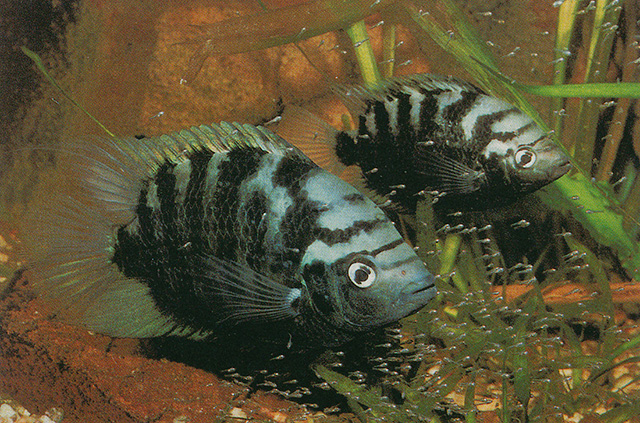| Cichlidae (Cichlids), subfamily: Cichlasomatinae |
| 11 cm TL (male/unsexed) |
|
benthopelagic; freshwater |
| Central America: Pacific slope, in tributaries of Fonseca Gulf in Honduras and Nicaragua; Atlantic slope in Río Chirripó (Río Matina) of Costa Rica to the Río San Juan and associated drainages of Nicaragua, including the Great Lakes. |
|
Dorsal spines (total): 15-17; Dorsal soft rays (total): 7-9; Anal spines: 9-11; Anal soft rays: 7-9. This species is distinguished by the following characters: 16- 19 total gill rakers on first arch, with rakers elongate and slender; 2 spots on opercle, vertically aligned; posterior end of maxilla not concave; circumpeduncular scales modally 18 or fewer; rows of secondary pored scales present on caudal fin; bars on side of body extending partially onto dorsal and anal fins, no medial intensification in bars on side of body, ocellus present on dorsal fin of mature females; in life abdomen predominantly yellow-green; caudal blotch ocellated (Ref. 74403). |
| Inhabits mainly shallow waters or swampy areas of lakes and rivers. Often found in many eutrophic oxbow lakes, ponds, roadside ditches and remnant pools of floodplains with thick vegetation. Prefers warm temperature and thrives in stagnant waters. An open water substrate spawner which lays eggs in extreme shallows. Fry feed on parents' dermal mucus for first few days (Ref. 7335). Feeds on detritus and insects (Ref. 36880). |
|
Least Concern (LC); Date assessed: 07 November 2019 Ref. (130435)
|
| harmless |
Source and more info: www.fishbase.org. For personal, classroom, and other internal use only. Not for publication.
